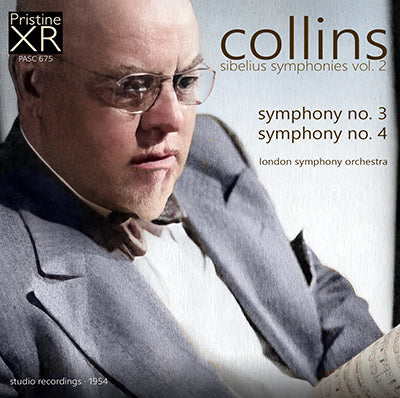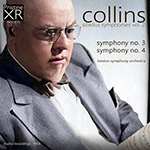
This album is included in the following sets:
This set contains the following albums:
- Producer's Note
- Full Track Listing
- Cover Art
Sibelius's third symphony has been regarded as more classical than his previous works. The scholar Gerald Abraham has argued that the first movement bears strong comparison with the first movements of Haydn's and Mozart's symphonies. Against this background, it seems all the more remarkable that the history of its composition has turned out to be quite complicated.
Influences from Finnish folk music are discernible in the very first chords of the symphony. There were also some programmatic notions behind it. In Paris in January 1906, after a period of lively celebrations, Sibelius played three themes to the painter Oscar Parviainen. These were: Funeral March, A Prayer to God and A Great Feast. The scholar Markku Hartikainen has shown that these themes were probably connected with Jalmari Finne's libretto for the oratorio Marjatta, which Sibelius did not manage to compose despite several attempts. However, the Prayer to God theme ended up as a hymn theme within the finale of the third symphony – and it also appeared on the wall at Ainola, for the theme inspired Oscar Parviainen to produce a painting for Sibelius.
In 1906 Sibelius completed the orchestral poem Pohjola's Daughter. The sketches for the work contain material which ended up in the third symphony. Thus, it seems that the symphony, which in itself was heard as a non-programmatic work, received - as is often the case with Sibelius - its initial stimulus from various programmatic ideas; these lost their programmatic meaning during the process of composition as the material was reworked in purely musical terms.
Sibelius conducted the first public performance on 25th September 1907. The reviews were mixed: Karl Flodin praised the work, but the Helsingin Sanomat reviewer claimed that the direct impact of the work was weaker than that of the first symphony.
Stylistically, Sibelius was now approaching notions of Neoclassical music in ways that his friend Ferruccio Busoni would write about a short time later. Sibelius's third symphony is more condensed than its predecessors. Now there are three movements instead of four, since the scherzo and the finale are combined more organically than in the second symphony.
Romanticism is replaced by functionalism, and the orchestration is lighter than before, with no tuba or harp. In his old age Sibelius was of the opinion that the third symphony need not be performed with an orchestra of more than fifty players.
"The symphony meets all the requirements of a symphonic work of art in the
modern sense, but at the same time it is internally new and revolutionary –
thoroughly Sibelian."
Karl Flodin, critic, 1907
"After hearing my third symphony Rimsky-Korsakov shook his head and said:
'Why don't you do it the usual way; you will see that the audience can
neither follow nor understand this.' And now I am certain that my
symphonies are played more than his."
Jean Sibelius, 1940
"The third symphony was a disappointment for the audience, as everybody was
expecting that it would be like the second. I mentioned this to Gustav
Mahler, and he also observed that 'with each new symphony you always lose
listeners who have been captivated by previous symphonies'."
Jean Sibelius, 1943
The fourth symphony was once considered to be the strangest of Sibelius's symphonies, but today it is regarded as one of the peaks of his output. It has a density of expression, a chamber music-like transparency and a mastery of counterpoint that make it one of the most impressive manifestations of modernity from the period when it was written.
Sibelius had thoughts of a change of style while he was in Berlin in 1909. These ideas were still in his mind when he joined the artist Eero Järnefelt for a trip to Koli, the emblematic "Finnish mountain" in Karelia, close to Joensuu. The landscape of Koli was for Järnefelt an endless source of inspiration, and Sibelius said that he was going to listen to the "sighing of the winds and the roar of the storms". Indeed, the composer regarded his visit to Koli as one of the greatest experiences of his life. "Plans. La Montagne," he wrote in his diary on 27th September 1909.
The following year Sibelius was again travelling in Karelia, in Vyborg and Imatra, now acting as a guide to his friend and sponsor Rosa Newmarch. Newmarch later recollected how Sibelius eagerly strained his ears to hear the pedal points in the roar of Imatra's famous rapids and in other natural sounds.
The trip also had other objectives. On his return Sibelius wanted to develop his skills in counterpoint, since, as he put it, "the harmony is largely dependent on the purely musical patterning, its polyphony." His observations contained many ideas on the need for harmonic continuity. Since the orchestra lacked the pedal of the piano, Sibelius wanted to compensate for this with even more skilful orchestration.
Yet one more natural phenomenon – a storm in the south-eastern archipelago – was needed to get the symphonic work started. In addition, in November 1910 he was preparing the symphony at the same time as he was working on music for Edgar Allan Poe's The Raven, which he had promised to Aino Ackté. The Raven was never finished, but its atmosphere and sketches had an effect on the fourth symphony.
The symphony was performed for the first time on 3rd April 1911, in Helsinki. Its tone was both modern and introspective, and it confused the audience so much that the applause was subdued. "Evasive glances, shakes of the head, embarrassed or secretly ironic smiles. Not many came to the dressing room to deliver their congratulations," Aino Sibelius recollected later. The critics, too, were at a loss. "Everything was so strange," was how Heikki Klemetti described the atmosphere. In the years that followed audiences in many parts of the world reacted the same way.
"The motif of the symphony is a journey to the famous mountain Koli, which
rises 252 metres above the level of Lake Pielisjärvi (…) [As regards the]
magnificent connection which Sibelius has previously made with our people
and its national epic and which has made him so strong and great, this bond
is lacking in the fourth symphony."
Bis, i.e. the critic Karl Fredrik Wasenius in Hufvudstadsbladet, 1911
"The assumptions of the pseudonymous Bis concerning the programme of my new
symphony are incorrect. I guess that they have to do with the topographical
report which I presented to a few friends on 1st April."
Jean Sibelius in Hufvudstadsbladet, 1911
"The future will decide whether in the melodic structure of some the themes
the composer has crossed the boundary that healthy natural musicality
instinctively sets for the play of intervals in a melody."
Heikki Klemetti, critic,1911
"A declaration of war against that superficiality, admiration of outward
devices, empty grandiloquence and overwhelming materialism which is
swallowing up modern music."
Evert Katila, critic in the newspaper Uusi Suomi, 1911
"I feel as if entirely new worlds were now opening for Sibelius as a
composer of symphonies, worlds which have not been shown to others and
which he, with his astonishingly highly developed sense of colour and
melody, can see and describe to others."
Oskar Merikanto, critic in the newspaper Tampereen Sanomat, 1911
"We have very good reasons to call the style of the fourth symphony
expressionism. This is because the line has a dominant position in the
work. (…) The fourth symphony exerts a healthy influence. It involves a
quiet protest against all hollow impressionism, tasteless instrumentation
and low naturalism.
Erik Furuhjelm, scholar, 1916
"I am pleased that I did it, for even today I cannot find a single note in
it that I could remove, nor can I find anything to add. This gives me
strength and satisfaction. The fourth symphony represents a very important
and great part of me. Yes, I'm glad to have written it.
Jean Sibelius in the 1940s
Notes and quotes from Sibelius – The Website: http://www.sibelius.fi
COLLINS The Sibelius Symphonies, Volume 2
1. 1st mvt. - Allegro moderato (9:28)
2. 2nd mvt. - Andantino con moto, quasi allegretto (7:30)
3. 3rd mvt. - Moderato - Allegro ma non tanto (7:59)
Recorded Kingsway Hall, London, 5-6 May 1954
First issued as Decca LXT 2960
SIBELIUS Symphony No. 4 in A minor, Op. 63
4. 1st mvt. - Tempo molto moderato, quasi adagio (8:50)
5. 2nd mvt. - Allegro molto vivace (4:05)
6. 3rd mvt. - Il tempo largo (8:56)
7. 4th mvt. - Allegro (10:17)
Recorded Kingsway Hall, London, 22-25 February 1954
First issued as Decca LXT 2962
London Symphony Orchestra
conducted by Anthony Collins
XR Remastered in Ambient Stereo by Andrew Rose
Cover artwork based on a photograph of Anthony Collins
Decca studio recordings
Symphony 3 producer: Peter Andry
Symphony 4 producer: Victor Olof
Engineer: Kenneth Wilkinson
Total duration: 75:16

